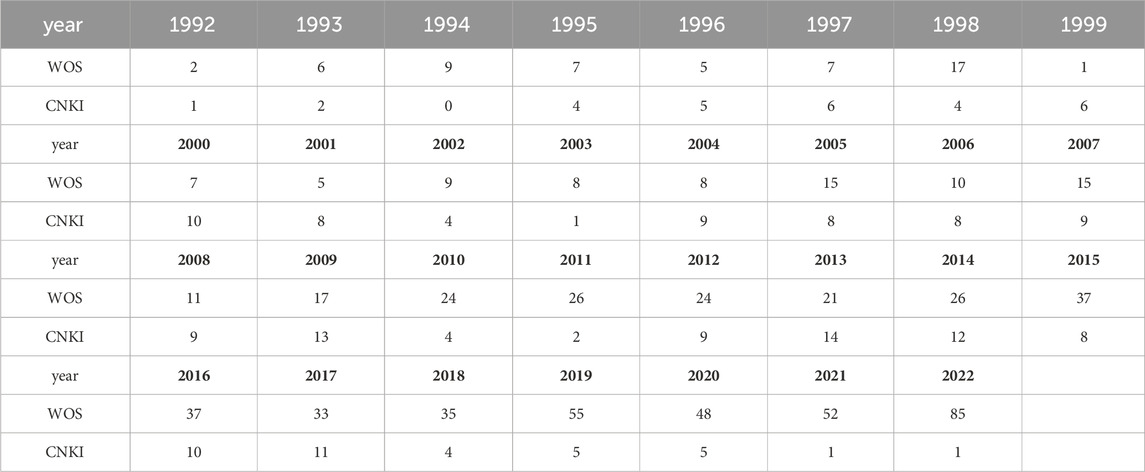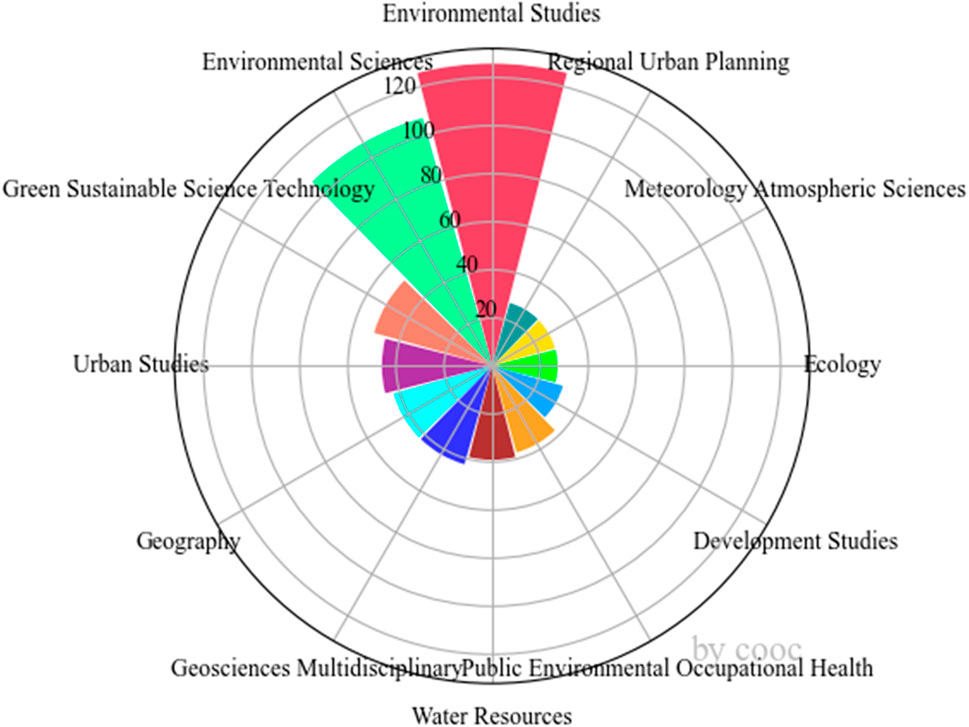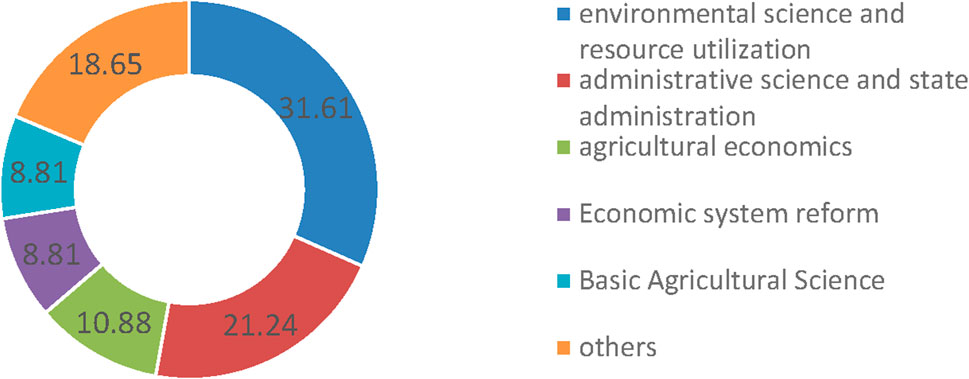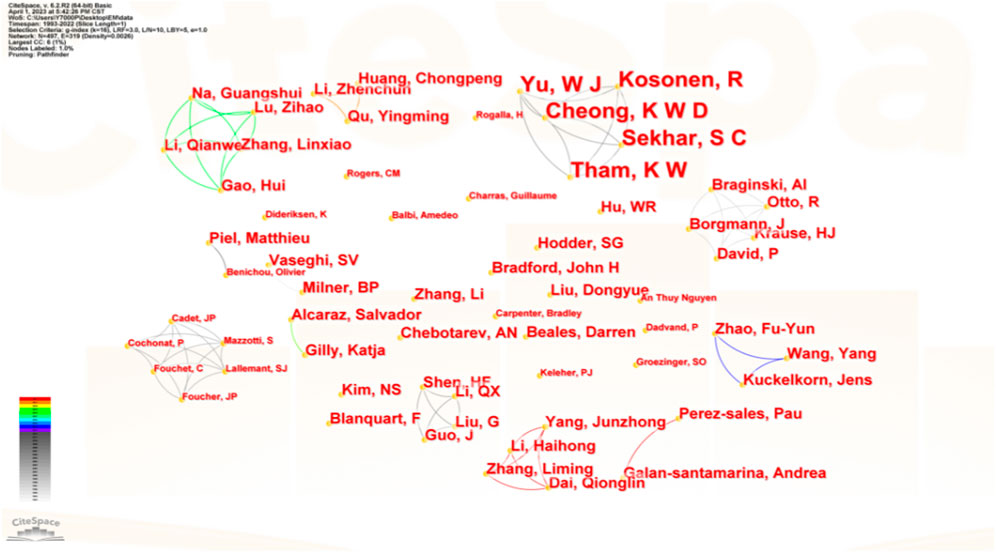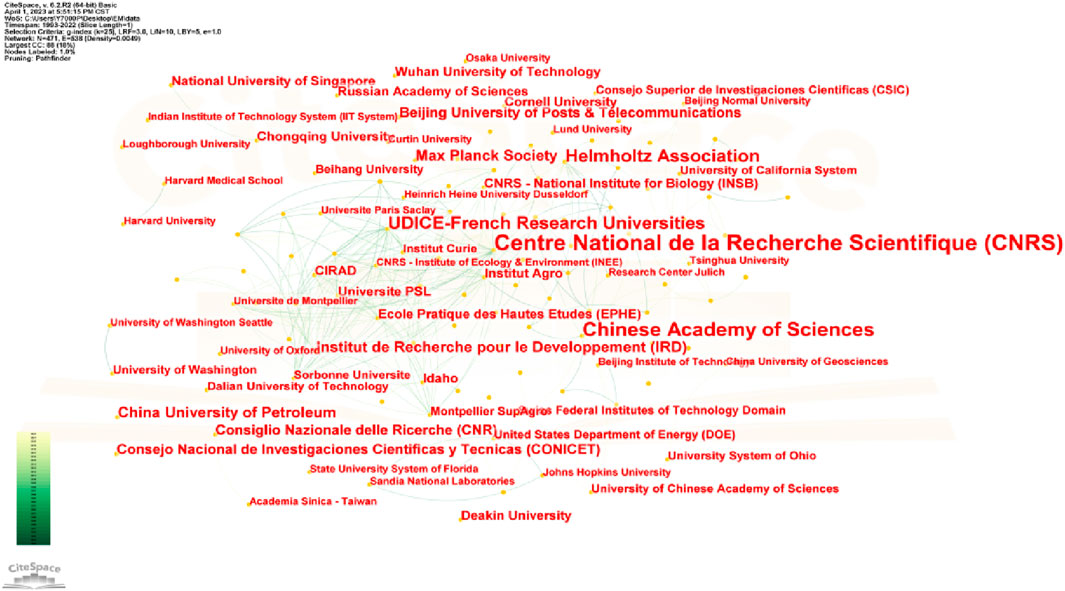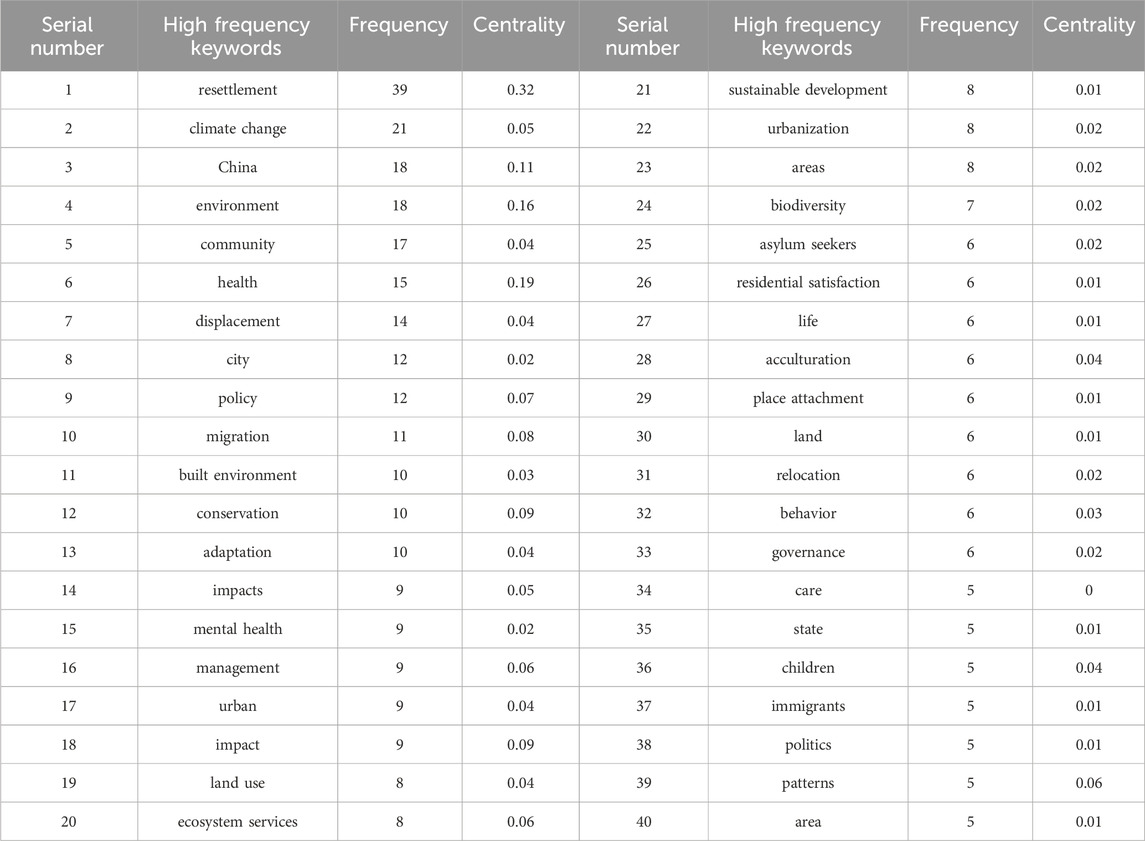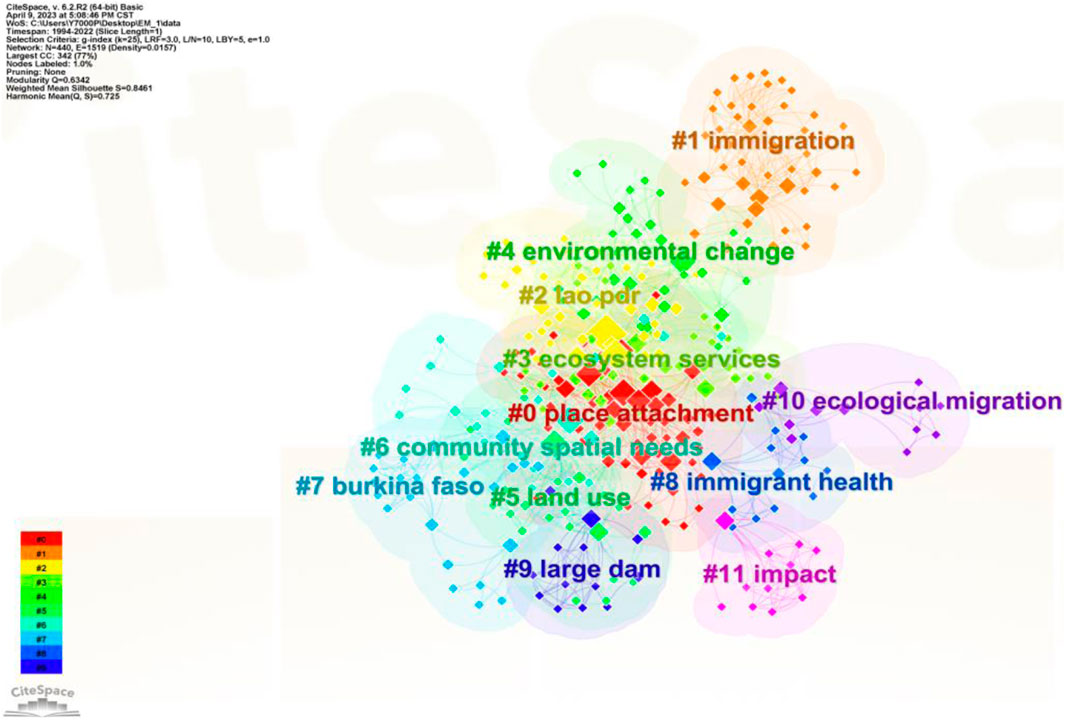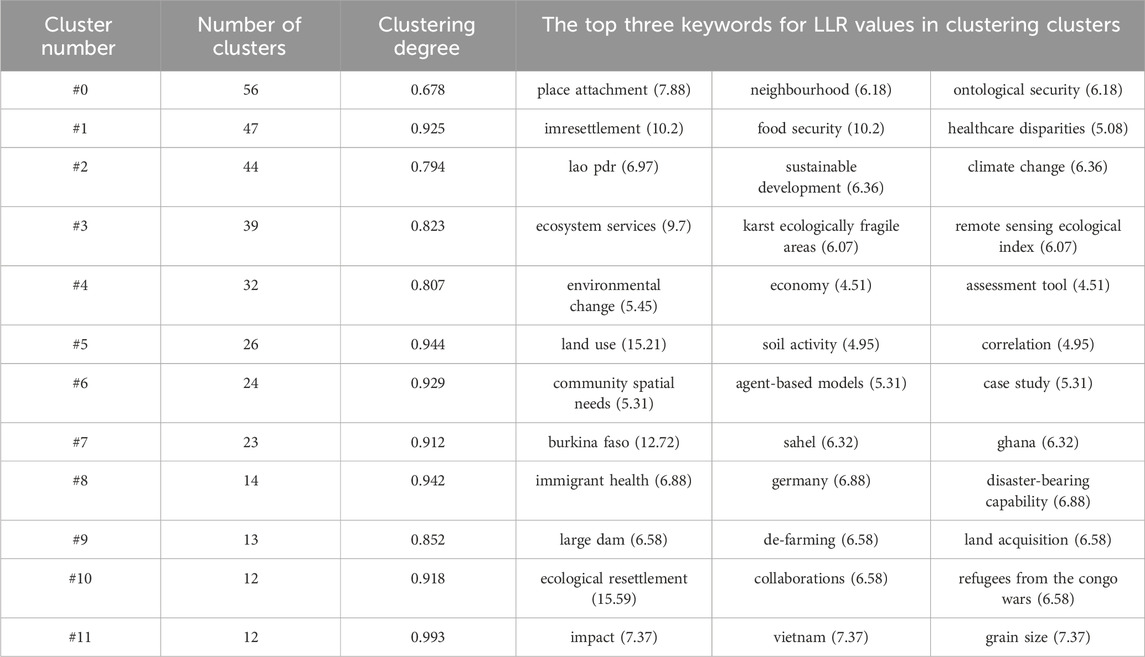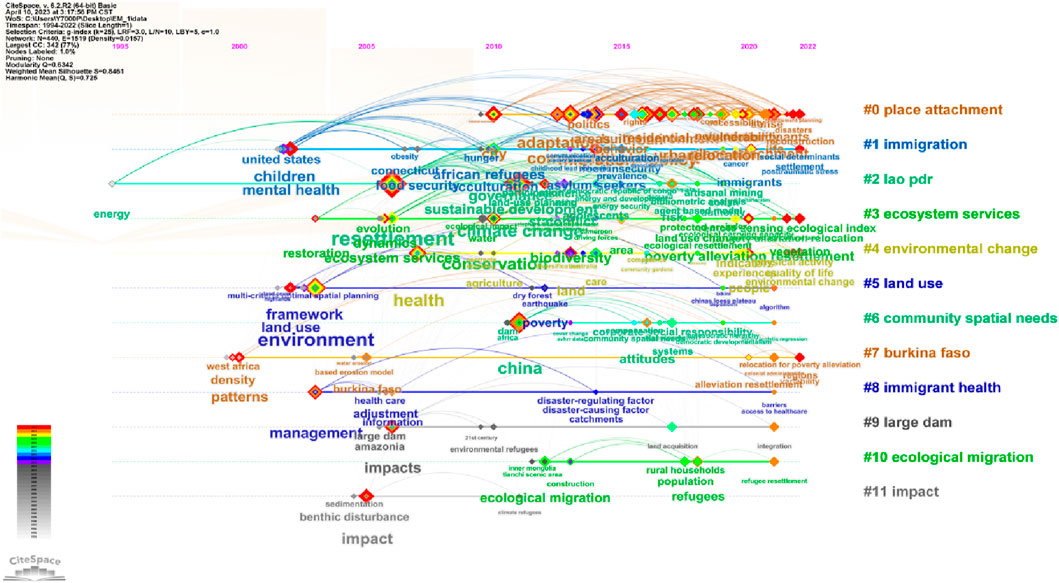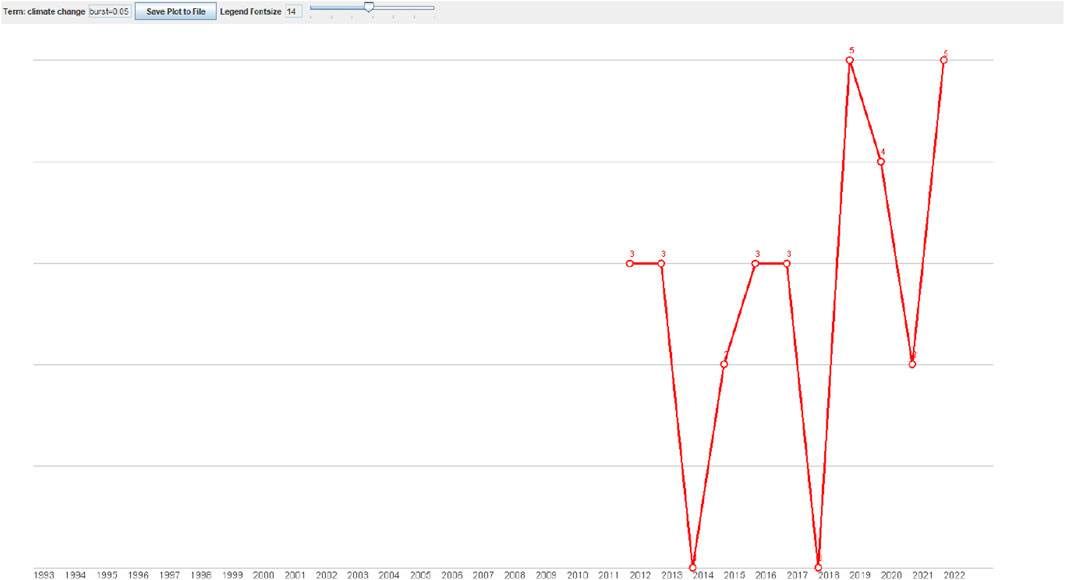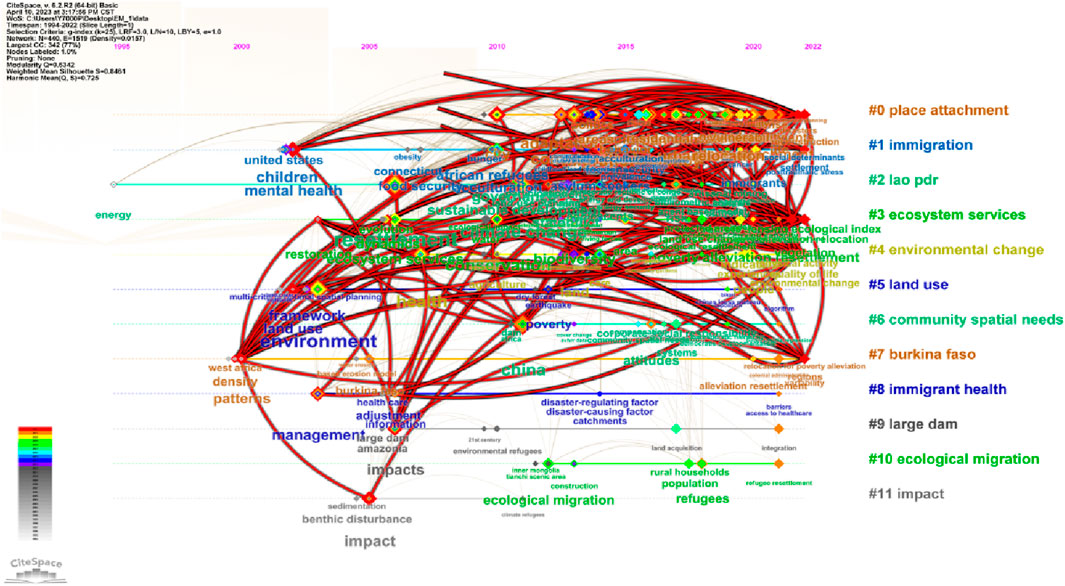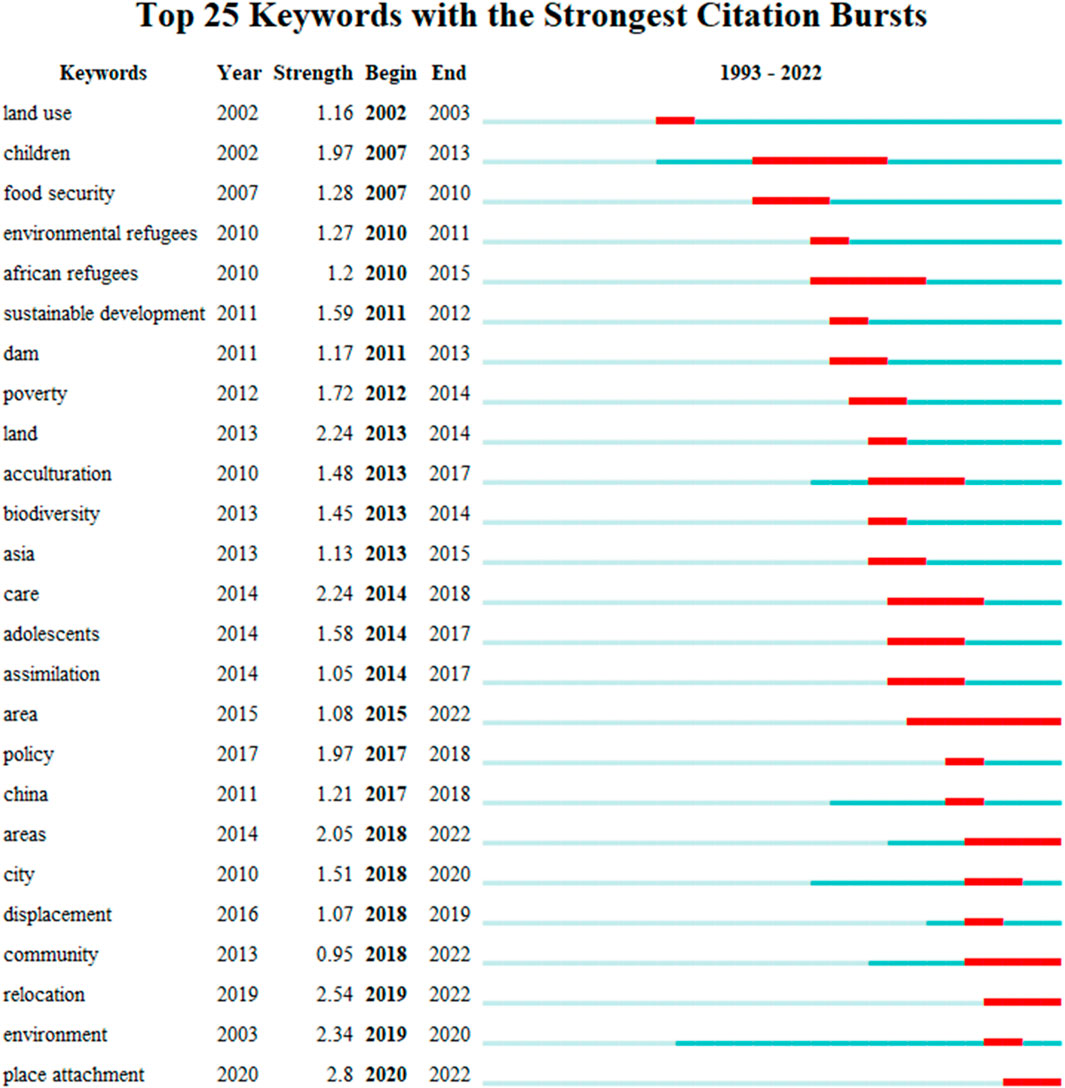- 1National Research Center for Resettlement, Hohai University, Nanjing, China
- 2Jiangsu Provincial Party School of the Communist Party of China, Nanjing, China
- 3School of Economics and Management, Guizhou Qiannan University of Science and Technology, Qiannan, China
Introduction: Global environmental issues have become one of the most prominent risk issues in society, and it is of great theoretical and practical importance to study the intrinsic correlation between environmental change and population migration.
Methods: Based on the Web of Science core ensemble database (WOS) and National Knowledge Infrastructure database (CNKI) sources, CiteSpace visual bibliometric software was used to construct a map of research hotspots in the field of environmental migration. The specific research methods included word frequency analysis, cluster analysis, and burst word detection analysis.
Results: The study found that the research hotspots of environmental migration mainly include:migration caused by environmental pollution; migration caused by the construction of environmental protection projects; migration caused by environmental protection activities; migration caused by environmental degradation; migration caused by climate change; migration caused by environmental disasters; and migration caused by environmental improvement activities.
Discussion: Our new insights into the relationship between environmental factors and migration include:non-linear relationships, multi-dimensional vulnerability, livelihood diversification, local context and agency, feedback loops and feedback effects. For future research directions on environmental migration, we can start from the following aspects: (1) Multidisciplinary Approaches; (2) Longitudinal Studies; (3) Regional and Localized Studies; (4) Climate Change Projections; (5) Policy Impact Analysis; (6) Migration and Urbanization; (7) Social and Cultural Adaptation; (8) Technological and Data Advancements; (9) Ethical Considerations; (10) Community-Based Research.
1 Introduction
With the development of society, many environmental issues have become increasingly internationalized. Data show that humans generate over 2 billion tons of urban solid waste annually, of which 45% is not properly treated (Yang et al., 2012). If urgent action is not taken, the amount of urban solid waste generated by humans will rise to nearly 4 billion tons by 2050 (Huo et al., 2007). This will increase the degree of pollution of the environment where humans live and lead to an increase in morbidity and mortality (Al-Kindi et al., 2020). In addition, environmental disasters pose serious risks to humanity. Landslides are frequent and widely distributed disasters in China with serious impacts (Derbyshire, 2001). They often bring enormous losses to industrial and agricultural production as well as to people’s lives and property. The main risks of landslides in rural areas are the destruction of farmland and houses, harm to people and livestock, the destruction of forests, roads, agricultural machinery, water conservancy and electric infrastructure and sometimes even more destructive damage (Fell et al., 2008). Common environmental disasters also include mudslides, which rush into rural and urban areas to destroy houses, factories, enterprises and other facilities, inundate people and livestock, destroy land, and cause village destruction and human death (Feng et al., 2019). Environmental issues include the adverse effects produced by the relocation of polluting enterprises, hazards or potential threats posed by the contaminated area to human health and environmental safety, and redevelopment problems for the land. These factors make the problem of contaminated sites that are hidden behind the relocation of industrial enterprises present to the public (Fasheng, 2010). To mitigate the impact of these environmental problems, the transition to low-carbon energy systems is inevitable (Kern and Rogge, 2016). This transition process will face not only economic and technical issues in supporting new energy systems but also new challenges in incorporating just transition principles into transition planning (Hoang and Nguyen, 2021).
On 13 September 2022, the United Nations released a news report stating that environment-related hydroenvironmental hazards such as tropical cyclones, floods and droughts are growing in frequency and intensity, which is increasing the number of risk hot spots (Sachs et al., 2022). Low-lying and other small island countries, countries with low-lying coastal areas, arid and semiarid areas, or areas susceptible to floods, droughts, and desertification, as well as developing countries with fragile mountain ecosystems are highly vulnerable to the adverse effects of environmental change (Nicholls et al., 2007). Different types of environmental changes may lead to different types of population migration. Climate change causes migration issues, as do atmospheric pollution and other related environmental protection projects and construction (Black et al., 2011). A study found that in recent years, the degree of harm caused by hazy weather in China has increased, which has seriously disrupted people’s lives. Some regions have already experienced a small amount of population migration caused by environmental issues such as air pollution (Gao et al., 2017). Major projects such as waste incineration plants and landfills often involve the large-scale relocation of entire villages and towns (Zhang et al., 2015).
The World Migration Report 2022 released by the International Organization for Migration (IOM) identified approximately 281 million international migrants in the world in 2020, equivalent to 3.6% of the global population; this was an increase of 3.5% compared to 227.2 million in 2019 (Chuang, 2022). In addition, the IOM predicted that there will be 200 million environmental immigrants by 2050, and the number of immigrants due to environmental change may subsequently reach 700 million (Veeramoothoo, 2022). IOM Director General Vittorino noted on World Environment Day that “the environment has been driving people to migrate, and disasters are responsible for displacing millions of people each year.” Migration is a relatively effective means of coping with environmental changes as people attempt to move to areas that offer better living conditions (Bradley and Erdilmen, 2022). In the face of increasingly prominent environmental migration brought about by the global environmental recession, some scholars have noted that environmental migration has become one of the most serious crises in human society (Warner et al., 2010). It is crucial to develop good environmental disaster response strategies and conduct disaster-avoidance migration general planning.
Current environmental issues threaten the production and life of the affected population. The transition to a new energy system may also affect the production activities of vulnerable groups and may even deepen this inequity (Hoang et al., 2021). Due to the different national conditions and regions, existing theories, models, and practical experiences of environmental migration urgently require further comparative research, innovation and development. In the transition to low-carbon energy, there is also an urgent need to ensure that vulnerable groups are treated fairly and equitably and that the principle of just transition is reflected in the planning and institutionalization of environmental migration (Jessee, 2020). Therefore, it is of great theoretical and practical importance to study the intrinsic correlation between environmental change and population migration, whether this involves the study of people’s migration in response to environmental change or the study of many concomitant problems that environmental migration brings to the economy, politics, society, culture, and environment (Borderon et al., 2019). Additional research priorities include conducting an impact assessment on environmental migration activities to ensure that the institutional regulations related to environmental migration are open and transparent and ensuring that disadvantaged groups receive fair and just outcomes. Bibliometric analysis, as an effective method to analyze the current status and trends of science and technology, has been widely used in various disciplines. In this paper, we use the literature related to environmental migration for meteorological purposes to analyze the evolutionary trends and hot topics of environmental migration research in the context of just transition.
2 The concept of “environmental migration"
In 1996, Swain used the term “environmental migration” for the first time. He suggested the use of “environmental migrants” rather than “environmental refugees” when referring to environmentally forced displacement to avoid legal and institutional problems and to make the term more targeted (Swain, 1996). Since the concept of environmental refugees cannot be supported at the level of international law and practical operation, the IOM proposed an operational definition of environmental migration in 2007 to unify understanding and promote international action: “Environmental migration is the forced or active, temporary or permanent departure of people or groups of people from their homes due to sudden or slow changes in the environment that adversely affect their lives or living conditions, and they can be either internal or international migrants" (Nations, 2001). The earliest systematic research on environmental migration in China was conducted by Xu Jiang from the Chinese Academy of Sciences, whose article “On Environmental Migration” (1995) presents the concept of environmental migration and defines it as the relocation of populations in a specific environmental context due to the deterioration of the natural environment on which people depend. The environmental capacity is not sufficient to sustain many people, which causes migration. Causes include natural disasters, ecological degradation, environmental pollution and other environmental factors (Xu et al., 1996).
In recent years, there has been some preliminary research on climate change and migration in China. This conceptual definition is quite similar to Bates’ classification of environmental refugees into disaster-type environmental refugees (Bates, 2002), land expropriation-type environmental refugees, and environmental degradation-type environmental refugees. However, China uses the term “migrants” rather than “refugees”. Although the introduction of this concept has played an important role in the study of ecological, environmental, and disaster migration, it seems that more detailed classification and elaboration of this classification is needed to facilitate research given the continuous practice of environmental migration in China. According to Yu Qingnian and Shi Guoqing, environmental migration refers to the planned relocation of polluting enterprises and their related persons out of cities and densely populated areas for the purpose of environmental protection and governance or the relocation of the population from environmentally polluted (Qing et al., 2024), fragile or degraded areas due to deteriorating living environment conditions and the reconstruction of socioeconomic systems to relocate enterprises, communities and families. The restoration of the livelihoods of affected populations due to restrictions or forced changes in resource use due to environmental damage is also called environmental migration. This definition is more complete (Guo Jianping, 2010). This study provides an econometric analysis of research evolution trends and hot topics in the field of environmental migration research based on the concept of migration proposed by the scholars Qingnian Yu and Guoqing Shi.
3 Data collection and methods
3.1 Data collection
The data used in this study were sourced from the core collection database of Web of Science (hereinafter referred to as “WOS”) and the China National Knowledge Infrastructure database (hereinafter referred to as “CNKI”). This study analyzed the research status, trends, and hot spots in the field of environmental migration in the past 30 years (from 1992 to 2022). The keywords searched in the CNKI database were “environmental migration” and “climate migration”. After screening each article and eliminating review papers, conference papers, media reports and searching duplicates, a total of 193 valid papers were obtained from the CNKI database1. The title words of the WOS database search were “environment migration”, “environment displacement”, and “environment refugee”, and the literature was screened in the same way as in the CNKI database. Finally, 661 valid documents were obtained from the WOS database2.
3.2 Methods
The specific research methods included word frequency analysis, cluster analysis, and burst word detection analysis. The specific technical software used included Origin mapping software, CiteSpace visual bibliometric software, and SPSS statistical analysis software.
3.2.1 Word frequency analysis
By analyzing the frequency of subject words in the literature, the hot topics of the discipline or the research field can be found, and the trend of the transfer of research hotspots can be identified through timeline mapping.
3.2.2 Clustering analysis
Clustering data on the basis of similar characteristics is used to compare the similarity between different data and is one of the basic tools to recognize the characteristics of unknown things. It follows the principle of hierarchical clustering, where the similarity of subject terms is clustered in order from the largest to the smallest.
3.2.3 Burst word detection analysis
A variable that spikes in value in a short time span becomes a hot topic and is suddenly noticed by the academic community; this can be regarded as the “Baidu index”. This variable can be keywords (frequency), authors, institutions, countries (number of publications), references (frequency of citations), and other dimensions. By detecting sudden words, we can identify the evolutionary trend of research in a certain field from macro to micro, from single to diversified, and review or predict which key branch technologies have become popular in a certain time period. We can even predict which key technologies can continue this explosive trend in the future.
4 Result
4.1 Statistical analysis of the literature
4.1.1 Statistical analysis by publication time
The study conducted a statistical analysis based on 661 journal-related studies sourced from WOS and 193 journal-related studies sourced from CNKI (Table 1). There were far more environmental migration-related studies in the WOS database than in the CNKI database. The studies on environmental migration in the WOS database showed exponential growth, while the growth in studies on environmental migration in the WOS database tended to be stable. Based on the literature related to environmental migration in the WOS database, the amount of environmental migration research can be divided into three stages: 1) in 1992–2004, the research on environmental migration was basically in a stable state, with an average annual number of 7 articles; 2) in 2005–2017, research on environmental migration showed an upward trend, with an average annual number of 23 articles; 3) in 2018–2022, research on environmental migration entered a high development stage, with an average annual number of 55 articles, and became a hot spot for academic and social attention.
4.1.2 Statistical analysis by discipline
The disciplinary classification to which the research literature belongs plays an important role in scientific research. The disciplinary division and the percentage of the content to be studied can be analyzed based on this. In this study, the top ten subject fields were selected from the literature database on environmental migration (Figure 1; Figure 2). The subject fields with a higher percentage in the WOS database were environmental studies, environmental science, green sustainable science and technology, and urban studies; the subject fields with a higher percentage in the CNKI database were environmental science and resource utilization, administrative science and state administration, and agricultural economics. Environmental migration is an interdisciplinary research field involving both natural and social sciences, which requires a high academic level for researchers in this field.
4.1.3 Statistical analysis by core authors
The analysis by core authors plays an important role in scientific research and, to some extent, reflects the current status of the research field and drives research forward. By using CiteSpace, a metrics software, this study analyzed the literature in both databases (Figure 3). The scholars Cheong Kwd, Sekhar Sc, and Tham Kw had more publications in the WOS database on environmental migration research in the target time period and were among the highly productive scholars in the field of environmental migration. In the CNKI database on environmental migration research, Guoqing Shi, Kling Wang, and Shaojun Chen were the top three scholars in terms of the number of articles published in the target time period and leading scholars in the field of environmental migration. Prof. Guoqing Shi is not only one of the scholars who co-published a paper on climate migration in Science on 28 January 2011, but also a Chinese scholar who published the most in Chinese and English overall. He also published a large number of papers on various migration policies, theories and applications in engineering, disaster, ecology, poverty alleviation, and mining.
4.1.4 Statistical analysis by major research institutions
The study analyzed the cooperation network among research institutions and generated the corresponding plots (Figure 4). The cooperation network for research was measured by co-publication in bibliometrics. The color of the network nodes indicates the distribution of the institutions’ published literature by time, and the color of the connection point represents the year of the first cooperation among research institutions. CNRS, Udizi French Research University, and the French Development Institute are among the highly productive research institutions in the field of environmental migration research internationally, and Hohai University and the Chinese Academy of Sciences are among the highly productive research institutions in the field of environmental migration research domestically.
4.2 Keyword frequency analysis
The keywords provide a summary of the research topic. The analysis of the keywords can quickly provide an understanding of the research topic of the paper. There is a connection between the keywords in a paper that is generally expressed by the “co-occurrence frequency”; the more the keywords appear together in the same paper, the closer the connection is. Keyword co-occurrence analysis is used to analyze the relationship between each topic in the literature by counting the frequency of the co-occurrence of keywords in the literature. Due to space constraints, the top 40 keywords in terms of word frequency were selected for this study (Table 2). The size of centrality reflects the strength of co-occurrence of the keyword with other keywords. The top three rankings in centrality were resettlement (0.32), health (0.19), and environment (0.16).
4.3 Keyword clustering analysis
In keyword cluster mapping, there are two values that determine whether the clustering effect is ideal: the clustering module Q value and the clustering average profile S value. When Q > 0.3, it indicates a significant clustering structure, when S > 0.5, it indicates more reasonable clustering, and when S > 0.7, it indicates a satisfactory clustering effect. In this study, the log likelihood ratio (LLR) was used to extract the clustering tag words for the keywords. The larger the LLR value is, the more representative the clustering tag words are. When the number of keywords in the general keyword clusters is greater than 10, it indicates that the clustering is meaningful. Keyword clustering analysis is based on keyword co-occurrence. In this study, keywords were clustered with metric software, and keyword clustering figures were obtained (Figure 5). The Q value in Figure 9 is 0.634 and the S value is 0.846, indicating that the keyword clustering structure is highly significant and that the clustering effect is satisfactory.
According to the LLR algorithm, a total of 12 clusters were obtained, and the number of keywords in all 12 clusters was greater than 10. This means that the clustering results were valid, so we obtained a total of 12 valid clusters (Table 3). The number of clusters indicates the total number of keywords included in the clusters, and the clustering degree indicates the similarity among the cluster members; the larger the value is, the more similar the clusters are. For example, in cluster 1, the number of clusters is 47, which means it contains 47 keywords. The tightness is 0.925, which means that the similarity between cluster members is very strong. The top three clusters selected by LLR values according to the log-likelihood algorithm are immigration (with an LLR value of 10.2), food security (with an LLR value of 10.2) and healthcare disparities (with an LLR value of 5.08).
4.4 Timeline graph analysis
Timeline mapping is a graph generated on the basis of clustering, where cluster members are arranged on the same line in the order of the timeline (Figure 6). Timeline mapping is mainly interpreted in four dimensions: “first time”, “hot”, “cold”, and “sign”. From Figure 9, we can see that the core keywords in cluster 0 (place attachment) are more densely distributed in red; the research tends to be hotter, and scholars pay more attention to these keywords. The core words in cluster 9 (large dam) are less distributed, indicating that the research of this cluster tends to be colder. The iconic keywords generally refer to words with higher intermediary centrality, and the keywords with purple outermost circles in the keyword chronogram are iconic keywords, such as communication contact, environmental service and adaptive capacity. For example, in cluster 2 (lao pdr) (Figure 7), the keyword “climate change” first appeared in 2010 among its cluster members. According to Figure 10, the frequency of the keyword appeared in a fluctuating upward trend and became a research hotspot. The evolutionary relationship of the highly mediated core words among the clusters over time can be clearly seen according to the keyword intercluster relationship evolution map, and the color of the connecting line indicates the corresponding year. Due to space limitations, Figure 8 is selected to show the evolution of the relationship map between clusters of environmental migration keywords in 2022.
4.5 Burst word detection analysis
Burst detection analysis is a text analysis method used to identify certain words or phrases that suddenly increase in frequency over a specific period of time. In implementing burst detection analysis, statistical techniques are usually employed to identify those words whose frequency in the text data sharply rises. These “burst words” or “hot words” can help researchers quickly grasp the focus of public attention or changes in social dynamics, thereby analyzing trends or predicting future developments. With regard to burst detection parameter settings, gamma takes the value range of 0–1. The smaller the gamma value is, the greater the number of burst words will be. The parameter minimum indicates the minimum unit of burst time (default 2 years, minimum 1 year); the smaller it is, the more burst words there will be. The parameter gamma is 0.1, and the parameter minimum is 2. The above parameters are used to obtain the keyword emergence map in the field of environmental migration research (Figure 9). “Begin” refers to the year when the keyword first appeared, and “end” refers to the year when the keyword disappeared. “Strength” refers to the intensity of the keyword’s emergence; the larger the value is, the more important it is. The red line indicates the time period when the keyword suddenly emerged.
5 Discussion
5.1 Division of research stages
Based on the above analysis, this study identified emergent words in keywords within a certain time period. Combining their evolutionary changes on the timeline with relevant literature studies and expert opinions, the study divided environmental migration research trends into three stages (Fig. 13).
5.1.1 This stage was the initial exploration stage (1992–1995)
This stage was the initial exploration stage of environmental migration research. The concept of environmental migration had not yet been introduced in this stage, and foreign scholars conducted a series of fruitful studies on “environmental refugees” in multiple dimensions.
5.1.2 This stage was the development and enrichment stage (1996–2017)
The term “environmental migration” was first conceptualized and used by Swain in 1996. Since then, there has been a large amount of research on “environmental migration”. The findings have focused on factors that induce migration due to environmental change, migration patterns due to different environmental types, and the health effects of environmental change and population migration.
5.1.3 This stage was the systematically deepening stage (2018-present)
Through the core words of mutation that appeared during this time in Figure 13, “city”, “community”, and “relocation”, it can be seen that in recent years, in-depth research has been conducted mainly in the areas of building capacity to cope with environmental change and relocation and resettlement in cities, communities, and rural areas.
5.2 Discussion of research hot spots in the field of environmental migration
In light of the previous econometric analysis of the relevant literature in the field of environmental migration and the views of experts and scholars in this field, there are seven main research hot spots in the field of research on environmental migration.
5.2.1 Migration caused by environmental pollution
Migration caused by environmental pollution refers to the intensification of environmental pollution from water, atmosphere, noise, light, soil, and solid waste. This pollution threatens the production and life of the people concerned, resulting in their willingness to migrate and carry out activities to rebuild economic and social systems in livable places. In essence, industrial societies have released excessive pollutants through their production and daily activities, compromising the environment’s self-regulating capacity. This environmental degradation leads to a decline in living conditions, prompting population migration. Yu Qingnian and Shi Guoqing explored the mechanism of population migration caused by environmental degradation and climate change, arguing that migration is the result of the interaction of climate, population growth, natural resources, political, economic, sociocultural and other elements (YuQingnia, 2010). Recently years, China’s hazy weather has increased the degree of harm and seriously disrupted people’s lives. Some areas have seen a small amount of population migration due to air pollution and other environmental problems (Zhiyue, 2019).
Jokisch distinguished between two types of environmental change based on how environmental events affect migration, that is, migration due to slowly and rapidly occurring environmental hazards (Jokisch et al., 2019). Tobias Rüttenauer and other researchers tested the probability of out-migration triggered by damage caused to subjects by air pollution and showed that subjective perceptions of air pollution increased the likelihood of mobility. This effect increased with income, which means that households with increasing incomes are more likely to decide to leave polluted areas than those with stable or decreasing incomes (Ruttenauer and Best, 2022). McLeman conducted a focus group in Toronto with 44 skilled workers who had recently migrated from Bangladesh and found that for a small but noteworthy number of participants, health impacts resulting from air pollution, water pollution, unsafe food and a lack of green space in Dhaka were the major motivators for the affected population to move to Toronto (McLeman et al., 2018). In a social risk assessment for the China-Pakistan Economic Corridor (CPEC), Max Finlayson systematically identified environmental drivers such as water, air, soil, noise, and biodiversity that had an impact on the construction of the CPEC. By establishing a model to calculate the assessed risks, the study classified noise as a medium risk category and other risks as a relatively high risk category. The study also provided relevant suggestions and recommendations for stakeholders to cope with the risks and promote smooth construction for the CPEC (Zhang et al., 2017).
The implications of pollution-induced migration are multifaceted, affecting urban planning, health services, and social structures in both the areas people leave and the areas to which they migrate. Furthermore, it poses a challenge for policymakers who need to address the root causes of environmental degradation while also managing the social and economic impacts on affected populations. As environmental concerns continue to rise, the phenomenon of pollution-induced migration highlights the urgent need for sustainable practices and robust environmental governance to prevent displacement and ensure the wellbeing of vulnerable populations worldwide.
5.2.2 Migration caused by the construction of environmental protection projects
To positively respond to environmental changes, environmental protection projects such as sewage treatment plants, landfills, waste incineration plants, sludge disposal sites, and garbage dumping sites have been constructed. The construction of similar projects will permanently or temporarily occupy land and demolish or relocate houses in the area affected by the project, which will result in migration caused by the construction of environmental protection projects. The purpose of environmental protection project construction is to harmlessly treat discharged waste to mitigate the damage to the environment. Construction itself adversely affects people, disturbs their normal lives, and may even affect their health and safety. In his discussion on migration science, Shi Guoqing suggests that the construction of urban infrastructure, which includes sewage treatment plants, waste transfer stations, and landfills, may cause serious localized impacts through permanent land or housing acquisition (Guoqing, 1999). For example, the establishment of the Quzhou City East Sewage Treatment Plant in China has had a serious impact on the production and life of migrants due to permanent land acquisition, temporary land occupation and house demolition (Chen, 2017). Furthermore, the shortage of water resources in northern China has seriously affected the production and life of residents and socioeconomic development. To alleviate the extent of drought in the northern region, the central government decided to transfer water from the Danjiang River, which has relatively abundant water resources, to the northern region. The construction of the Danjiangkou Project of the South‒North Water Transfer Central Line involved Henan and Hubei provinces, where 325,000 migrants were relocated and settled. It was also designed to alleviate population migration because of environmental changes (YAN Dengcai, 2017). Studies have been conducted to identify the sources of high risk in environmental engineering projects that affect social stability based on the theory of the social amplification of risks. These studies have also proposed corresponding opinions and suggestions for the prevention and resolution of risks in these engineering projects. When conducting high-risk environmental engineering projects, local governments and environmental protection departments should have a comprehensive understanding of various risk sources that threaten social stability, commission professional institutions to conduct assessments, and listen to the opinions of the public. They should formulate risk resolution plans in advance and perform crisis management (Zhang et al., 2018).
The migration caused by environmental protection projects presents a paradox where efforts to combat environmental degradation and promote sustainability inadvertently displace people. This has raised important considerations about the need for careful planning and community consultation in the implementation of such projects. It emphasizes the importance of developing mechanisms to minimize displacement and provide adequate compensation or relocation assistance to affected communities, ensuring that environmental gains are not achieved at the expense of social equity.
5.2.3 Migration caused by environmental protection activities
As a result of environmental protection activities that include the demolition and relocation of environmental protection areas, remediation, population relocation, restricted development and use, the relocation of polluting enterprises, and shoreline improvement of rivers and lakes in environmental protection areas such as water source protection areas, biodiversity protection areas, endangered animal and plant protection areas, and water and soil conservation areas, affected people will temporarily or permanently lose their settlement and production conditions and choose to relocate and rebuild their production and life (Power, 2008). This is called migration caused by environmental protection activities. In China, the construction of the South‒North Water Diversion Central Reservoir Water Source Protection Zone has damaged the basic livelihoods of affected farmers. Zhang Rui-lian and Shi Guoqing discuss the sustainable livelihood countermeasures of affected farmers from the perspectives of compensation subjects, contents and methods (ZHANG Ruilian, 2017). In the “post-South-to-North Water Transfer era”, ecological protection measures have been implemented at water sources to ensure high-quality drinking water, which has had a negative impact on the basic livelihoods of farmers (Wang and Du, 2011). The scholar Otsuk conducted field research on two migrant villages in Mozambique resulting from the construction of the Limpopo National Park Reserve and concluded that the resistance factors that emerged during the resettlement process indicate the need to focus on the built environment outside the nature reserve to address the violence in resettlement (Otsuki, 2023). To fundamentally curb the degradation of vegetation, land sanding and desertification in the Sanjiangyuan area, China has been exploring and establishing institutional mechanisms for ecological construction and environmental protection since 2003 and decided to establish the “Sanjiangyuan National Ecological Protection Comprehensive Pilot Area” in Qinghai Province after years of efforts. The establishment of the Sanjiangyuan Reserve requires the relocation of the affected population, and Qi Jinyu and Chen Xiaolu provide a general idea for the balanced development of environmental protection activities based on field surveys (Qi, 2020).
Environmental conservation activities can lead to migration on a global scale, impacting communities and individuals in various ways (Vinke et al., 2020). When conservation efforts prioritize protecting ecosystems or biodiversity, they can inadvertently disrupt livelihoods and traditional ways of life, prompting people to relocate (Reaser et al., 2022). The phenomenon of migration induced by environmental conservation underscores the importance of considering social impacts alongside environmental goals (Akpuokwe et al., 2024). Sustainable development approaches should prioritize inclusive and participatory decision-making processes that take into account the needs and rights of affected communities (Szetey et al., 2021). Balancing conservation efforts with social justice and equitable development is essential to address the complexities of environmental migration and ensure that vulnerable populations are not disproportionately affected by conservation activities (Ngcamu, 2023).
5.2.4 Migration caused by environmental degradation
The environmental conditions in several regions have begun to degrade and show a continuous trend of deterioration as a result of both natural conditions and development activities from human production, such as the degradation of grasslands, soils, forests and climatic conditions. The situation of the means of production and other developing conditions in the original localities has had a strong impact on the livelihoods of the residents, who need to improve their living standards. This results in corresponding migration activities. Neumann argues that migration arising from events such as climate change, land degradation, and sea level rise occurs slowly. Migration that occurs slowly is usually more complex than migration that occurs rapidly, which can limit our understanding of the interactions and mechanisms that lead to migration (Neumann and Hilderink, 2015). The research by Nicholas Van Hear suggests that environmental differences between the sending and receiving locations, including the presence or absence of resources, the relative fertility of the soil, water availability, and the degree of forest cover, can be predisposing factors for population migration (Van Hear, Bakewell and Long, 2018). Drawing on a study of two resettlement programs implemented in the Mekong Delta of Vietnam in the 2000s that were designed to reduce people’s exposure to environmental risks, Miller found that state-led resettlement programs were often designed to respond to life-threatening risks and lacked the capacity to support people in adapting to daily risks such as environmental degradation and reduced access to resources (Miller et al., 2022). In the arid regions of western China, where the ecological environment is extremely fragile, the grasslands and soils of the region are degraded to differing degrees, and the government has begun an organized process of migration, relocation and community reconstruction. For example, a large part of Ningxia is located in the arid and semiarid zone where environmental degradation and poverty intersect, creating barriers to the development of sustainable livelihoods in the region. To alleviate these problems, in 2002, a total of 79 project areas were completed in the arid zone population relocation project in central Ningxia, developing 1.223 million mu of land and relocating 1.11 million migrants (LI Ruchun, 2013). The rural economies of Haiti and the Dominican Republic also suffer from the effects of slowly occurring environmental degradation. Stefan Alscher analyzed the impact of environmental change on migration flows within and outside Hispaniola based on field studies in selected areas of both countries. The study found that environmental degradation, mainly the effects of deforestation, soil erosion and tropical storms (floods, landslides), exacerbated existing economic problems and accelerated the decision to migrate (Alscher, 2011). Relocation activities caused by environmental degradation are prone to social conflicts, which can be avoided by establishing compensation mechanisms, increasing migrants’ participation, strengthening social evaluation, rebuilding migrants’ social capital, government responsibility, and institution building (Shi et al., 2009).
Global environmental degradation is a significant driver of migration, impacting populations worldwide. As ecosystems deteriorate and natural resources become scarce or contaminated, individuals and communities are compelled to leave their homes in search of safer and more sustainable living conditions (Ayeb-Karlsson, 2021). Addressing migration due to environmental degradation requires comprehensive strategies that integrate environmental sustainability, social justice, and human rights considerations. Efforts should focus on mitigating environmental damage, building resilience in vulnerable communities, and providing support for displaced populations to ensure their wellbeing and dignity amidst changing environmental conditions (Marcus et al., 2023).
5.2.5 Migration caused by climate change
The extreme and erratic climate associated with rising sea levels, increasing desertification, and frequent droughts and floods has given rise to a large number of “climate migrants” who must relocate due to climate change, ecological imbalance, geological variability, and environmental pollution. The United Nations Environment and Human Security Organization (EHSO) predicted in 2009 that the number of climate refugees affected by climate disasters worldwide would be 243 million per year between 1998 and 2007, and the number of climate refugees would reach more than 375 million after 2015. Migration caused by climate change is likely to lead to regional conflicts and refugee flows and has become an increasing focus of research by scholars at home and abroad. Liang Bing and Shi Guoqing summarized seven main types of climate migrants: migration resulting from sea level rise, migration resulting from floods, migration resulting from worsening droughts, migration resulting from extreme weather events, voluntary migration resulting from climate change discomfort, engineering migration resulting from climate change response engineering measures, and migration resulting from the disruption of fishermen’s livelihoods caused by climate change (Liang et al., 2023).
Currently, sea level rise is threatening island nations, mainly in the Pacific, such as Kiribati and Tuvalu. For their inhabitants, relocation is the only option (Constable, 2017). Studies have found that population displacement from floods or heavy rains is only temporary, and most migrants choose to return to their original homes and rebuild (Thiede et al., 2016). Persistent drought causes livelihoods to decline, which can also lead to out-migration. In a migration study in Ethiopia, most of the respondents believed that drought increased rural migration (Ezra and Kiros, 2000). In terms of extreme climate events, flood hazards often affect parts of South America, while hurricane hazards often affect the Caribbean. Climate change has led to the migration of farmers via its impact on agricultural mechanisms (Kubik and Maurel, 2016). The government often formulates policies that require the relocation of people living in extremely fragile environments. For example, the Kiribati government developed a relocation program to address climate change issues (Barnett and McMichael, 2018). The impact of climate change on fisheries security and their livelihoods has also attracted considerable attention and research from scholars (McMichael et al., 2012). Adverse factors such as the continued degradation of the marine environment, sea level rise and marine disasters may destroy the livelihood of fishermen and increase their out-migration activities (Li Ruchun, 2017).
Climate change is a key driver of migration worldwide, with increasing impacts on populations and communities. As temperatures rise, weather patterns shift, and extreme events become more frequent, people are facing heightened risks and challenges that can necessitate relocation. Addressing climate change-induced migration requires coordinated efforts at local, national, and international levels. Adaptation strategies focused on building resilience, improving infrastructure, and diversifying livelihoods can help communities cope with climate impacts and reduce displacement pressures. Additionally, global cooperation on mitigation efforts to reduce greenhouse gas emissions is essential to limit future climate-related migration and protect vulnerable populations. Supporting climate migrants with adequate protection, assistance, and access to rights is crucial for ensuring human dignity and social justice amidst a changing climate.
5.2.6 Migration caused by environmental disasters
In areas prone to environmental disasters such as coastal and seismic zones, serious environmental disaster events often result in large-scale casualties and resource losses, such as bank collapses, landslides, ground collapses, mining area collapses, mudslides, storm surges, mountain collapses, tsunamis, floods and droughts. To avoid risk and to preserves their life and economic security, the residents move out of these disaster areas to seek shelter. As early as 2002, Myers claimed that hundreds of thousands of “environmental refugees” could eventually be at risk of displacement due to direct or indirect environmental problems (Myers, 2002). In response to the increasingly severe drought situation, the government of the Ningxia Hui Autonomous Region in China started a migration and relocation project. From 1983 to the present, the migration and relocation project in Ningxia, China, has undergone three phases with a total of 1.11 million migrants (Chen, 2012). In contrast, the megadrought event in 2010 in Southwest China did not induce extraordinarily large-scale migration activities. The results of the “climate change-population migration response” framework model show that local governments, village collectives and farm households have taken diverse adaptation measures so that migration activities are not a necessary choice for farm household members (Yu et al., 2011). Extreme and sudden environmental changes have increased the frequency of floods, storms, and other natural disasters in coastal areas, with densely populated and economically underdeveloped areas at greater risk, such as large deltas and some island nations in Asia and Africa. During June 3–20, 2011, heavy rains and floods in southern China affected approximately 36.57 million people and caused approximately 1.642 million people to be relocated (Shaojun, 2012). In view of the frequent occurrence of environmental disasters worldwide, Wang Haibao provided a decision-making basis for the further optimization of disaster-avoidance migration programs by constructing an evaluation model for disaster-avoidance migration planning and implementation (Wang Haibao, 2016). According to a survey conducted by the Chexi Lake Financial Services Administration in Huoqiu County, Anhui Province, the rationalization of resettlement locations, resettlement targets and subsidy policies has the most significant positive effect on resettlement, and the government should take measures to encourage farmers to resettle to promote the change from “resettlement by disaster” to “resettlement by danger" (Wang et al., 2020).
An empirical study by Asif Ishtiaque found that 18.43% of rural‒urban migrants in Dhaka, the capital city of Bangladesh, were caused by disasters and concluded that disaster-induced income decline was the main reason for their migration. The income of migrants affected by riverbank erosion fell by 89%, while the income of those affected by flooding fell by 70% (Ishtiaque and Nazem, 2017). Robert identified six possible thresholds for environmental adaptation and migration processes, although not all environmental hazards lead to population migration; in his view, specific migration thresholds need to be reached. For example, the dust storms of the 1930s in the southern Great Plains of the United States and the high seasonal precipitation in South and Southeast Asia and sub-Saharan Africa led to migratory movements of people, but more people chose to stay. The decision to migrate in the face of harsh environmental hazards is a function of the range of alternative adaptations available to a given household, which in turn are influenced by a wide range of cultural, demographic, economic, environmental, political, and social factors (McLeman, 2018).
Environmental disasters, including natural and human-induced events, have become a major cause of migration worldwide. As these disasters increase in frequency and intensity, they pose significant threats to human safety, homes, and livelihoods, often forcing people to relocate either temporarily or permanently. The migration triggered by environmental disasters highlights the vulnerability of affected populations, particularly in regions where infrastructure and emergency response are inadequate. To address this, disaster preparedness and mitigation strategies must be enhanced, including improved early warning systems, better urban planning, and more resilient infrastructure. Additionally, global and local policies must focus on supporting displaced populations through aid, rehabilitation, and sustainable resettlement programs, ensuring that migrants have access to necessary services and opportunities to rebuild their lives. International cooperation is also crucial in managing these disasters, sharing resources, and providing humanitarian assistance to affected populations.
5.2.7 Migration caused by environmental improvement activities
To improve damaged environmental conditions and promote sustainable social development, environmental improvement activities such as returning farmlands to forests, returning fisheries to lakes, and releasing the farming surface of rivers, lakes, and reservoirs have been undertaken. As a result of these activities, the residents of original settlements must move to new areas to carry out production activities either actively or passively. Migration caused by environmental improvement activities can be explained from the perspective of social vulnerability theory (Guo Jianping, 2013). Against the background of increasing ecological environmental protection by the government, the social vulnerability of farmers increases as a result of the return of farmlands to forests, fisheries to lakes, and rivers, lakes, and reservoirs to aquaculture surfaces, which leads to migration. Gulang County, Gansu Province, China, has conducted environmental improvement activities such as returning cultivated land to forest, grazing land to grass and sealing mountains to forest in key areas, including idle arable land, house bases and barren mountains and beaches, which has generated larger-scale migration (Xiaojie, 2021). Some studies have analyzed the livelihood vulnerability of fishermen from three perspectives: external shocks and stresses in the livelihood system of lost-sea fishermen, internal risk resistance in the livelihood system, and internal and external resilience outcomes. This provides a theoretical basis for the study of sustainable livelihoods among dislocated fishermen (Xu Yan, 2017). Guoqing and Chen (2014) analyzed the triggers of livelihood disruption for fishermen from the perspective of ideology theory with regard to sustainable livelihood. They discussed the external support system in terms of policy, organization and human resources as well as the diversified orientation of livelihood transformation with alternative functions and suggested relevant proposals for maintaining the sustainability of the livelihoods of fishermen who returned to the lake.
Environmental improvement activities, while primarily aimed at restoring and protecting ecosystems, can sometimes lead to migration. This displacement is often a consequence of large-scale environmental projects that, although beneficial in the long term, may disrupt existing communities in the short term. The phenomenon of migration due to environmental improvement underscores the need for careful planning and consideration of local community needs and rights. Ensuring participatory decision-making processes and providing fair compensation and relocation assistance are crucial to prevent adverse effects on local populations. Moreover, integrating social impact assessments into environmental planning can help balance ecological benefits with the wellbeing of affected communities, ensuring that environmental improvements do not come at the expense of social equity.
5.3 New insights between environmental factors and migration
5.3.1 Non-linear relationships
Previous studies often assume linear relationships between environmental factors (such as temperature, precipitation, or natural disasters) and migration patterns. However, recent research suggests that these relationships may be non-linear and complex. For example, the impact of environmental degradation on migration may vary depending on the severity and duration of environmental changes, as well as the resilience of local communities (Hoffmann et al., 2020). Understanding these non-linear relationships is crucial for developing more accurate predictive models and effective policy interventions.
5.3.2 Multi-dimensional vulnerability
Environmental migration is often portrayed as a direct consequence of environmental degradation. However, recent scholarship highlights the multi-dimensional nature of vulnerability, which includes not only exposure to environmental risks but also socio-economic factors, political instability, and access to resources (Ferguson et al., 2020). By adopting a broader perspective on vulnerability, researchers can better understand the diverse drivers of migration and design more holistic adaptation strategies (Schipper, 2020).
5.3.3 Livelihood diversification
Migration is often viewed as a coping strategy in response to environmental stressors. While this is true in many cases, recent studies emphasize the importance of livelihood diversification as a proactive adaptation strategy (Hoffmann, Wiederkehr, Dimitrova and Hermans, 2022). Rather than viewing migration as a last resort, communities may engage in various livelihood activities (such as agriculture, tourism, or entrepreneurship) to reduce their dependence on vulnerable environmental resources and enhance their resilience to future shocks.
5.3.4 Local context and agency
Environmental migration is often portrayed as a passive response to external environmental pressures. However, recent research highlights the agency and decision-making processes of migrants and local communities (De Haas, 2021). Factors such as social networks, cultural norms, and institutional arrangements play a crucial role in shaping migration outcomes (De Haas, 2021). By incorporating a more nuanced understanding of local context and agency, researchers can better capture the complexities of migration dynamics and design more contextually relevant interventions.
5.3.5 Feedback loops and feedback effects
Environmental changes can create feedback loops that amplify migration pressures and exacerbate existing vulnerabilities (Asaka, 2021). For example, climate-induced disasters can lead to displacement, which in turn can strain receiving communities and exacerbate social tensions (Lenshie et al., 2022). Understanding these feedback loops is essential for predicting migration patterns and designing effective adaptation and mitigation strategies that address underlying drivers of vulnerability.
By incorporating these insights into research on environmental migration, scholars can advance our understanding of the complex interactions between environmental factors and migration dynamics, ultimately informing more effective policy responses to environmental change and human mobility.
6 Future research direction
Following research directions have been recommended:
(1) Multidisciplinary Approaches
Future research should integrate insights from various disciplines such as environmental science, sociology, economics, political science, and geography. This multidisciplinary approach will provide a comprehensive understanding of the complex interplay between environmental factors and migration patterns.
(2) Longitudinal Studies
There is a need for longitudinal studies that track environmental migrants over extended periods. Such studies would offer valuable insights into the long-term impacts of environmental changes on migration decisions and the socioeconomic outcomes for migrants and their communities.
(3) Regional and Localized Studies
While global studies provide a broad overview, regional and localized studies are essential to understand the specific drivers and impacts of environmental migration in different contexts. This would include examining how local environmental policies, economic conditions, and cultural factors influence migration.
(4) Climate Change Projections
Future research should incorporate climate change projections to predict potential hotspots of environmental migration. This would help in planning and implementing adaptive measures to mitigate the impacts of future environmental changes on vulnerable populations.
(5) Policy Impact Analysis
Analyzing the effectiveness of existing policies and frameworks aimed at managing environmental migration is crucial. Research should focus on evaluating policy responses at local, national, and international levels, identifying best practices, and recommending improvements.
(6) Migration and Urbanization
The relationship between environmental migration and urbanization needs further exploration. Studies should examine how environmental migrants integrate into urban areas, the challenges they face, and the impact of their influx on urban infrastructure and services.
(7) Social and Cultural Adaptation
Research should delve into the social and cultural adaptation of environmental migrants in their new locations. Understanding how migrants maintain their cultural identity and integrate into new communities can inform policies to facilitate smoother transitions and social cohesion.
(8) Technological and Data Advancements
Leveraging advancements in technology and data analytics can enhance the study of environmental migration. The use of satellite imagery, GIS, and big data can improve the accuracy of migration models and provide real-time monitoring of environmental changes and migration flows.
(9) Ethical Considerations
Future research should address the ethical dimensions of environmental migration, including the rights of migrants, the responsibilities of sending and receiving regions, and the implications of forced versus voluntary migration.
(10) Community-Based Research
Engaging directly with communities affected by environmental migration can provide valuable grassroots perspectives. Participatory research methods can empower communities, ensuring that their voices are heard in academic and policy discussions.
By addressing these future research directions, scholars can contribute to a more nuanced and holistic understanding of environmental migration, ultimately informing policies and practices that better support affected populations.
7 Conclusion
This review explored the multifaceted phenomena of environmental migration, synthesizing findings from various studies to build a comprehensive understanding of how environmental changes compel migration. We have seen that factors such as climate change, natural disasters, and resource depletion act both independently and synergistically to influence migration patterns. Importantly, the adaptive strategies adopted by communities and individuals are diverse, often influenced by socioeconomic, political, and cultural contexts which can either exacerbate or mitigate the migration pressures. This review underscores the urgent need for policies that not only address the immediate impacts of environmental changes but also incorporate long-term sustainable solutions to assist those displaced. As the planet continues to face unprecedented environmental challenges, the integration of environmental migration considerations into global policy making becomes indispensable for fostering resilience and securing human wellbeing in affected regions worldwide. International research on environmental migration is limited to analyses from the perspective of problem origins and specific cases and lacks systematic and comprehensive theories, methods, and macro- and meso-scale policy and strategy studies. Environmental migration is a cross-cutting research field that integrates multiple disciplines (e.g., environmental science and management, atmospheric science, meteorology, hydrology, oceanography, geography, demography, economics, management, sociology, psychology, agronomy, water engineering) and requires scholars from different disciplinary backgrounds to join in the research.
Data availability statement
The raw data supporting the conclusion of this article will be made available by the authors, without undue reservation, inquiries can be directed to the corresponding authors.
Author contributions
YS: Writing–review and editing. BL: Writing–original draft. GS: Conceptualization, Writing–review and editing. ZS: Supervision, Writing–review and editing. YH: Formal Analysis, Writing–review and editing. TY: Data curation, Writing–review and editing. ZL: Writing–review and editing.
Funding
The author(s) declare that no financial support was received for the research, authorship, and/or publication of this article. This work was Supported by the Fundamental Research Funds for the Central Universities:Climate Migration Types and Risk Management in Coastal Areas. (grant number B230205032); & Postgraduate Research & Practice Innovation Program of Jiangsu Province:Climate Migration Types and Risk Management in Coastal Areas. (grant number: KYCX23_0644); and The Key Research Project of the National Foundation of Social Science of China:Community Governance and Post-relocation Support in Cross District Resettlement [grant number 21&ZD183].
Acknowledgments
We are grateful for the scientific research platform provided by Hohai University, the valuable revision opinions of the review experts, and the people who provided help in the process of writing the paper.
Conflict of interest
The authors declare that the research was conducted in the absence of any commercial or financial relationships that could be construed as a potential conflict of interest.
Publisher’s note
All claims expressed in this article are solely those of the authors and do not necessarily represent those of their affiliated organizations, or those of the publisher, the editors and the reviewers. Any product that may be evaluated in this article, or claim that may be made by its manufacturer, is not guaranteed or endorsed by the publisher.
Footnotes
1Due to the relatively limited literature on the CNKI database of environmental migration, this study only focuses on the overall situation of its literature and does not analyze its research hotspots and trends, and select relevant literature from the WOS database to analyze the evolutionary trends and hot topics of environmental migration research
2Due to the large number of WOS literature, it is difficult to analyze. The search for topics was changed to titles, and after screening, a total of 661 valid literature were obtained. Then, we conduct an in-depth analysis among these 661 literature
References
Akpuokwe, C. U., Eneh, N. E., Adeniyi, A. O., and Bakare, S. S. (2024). Migration trends and policies: a review of African and USA perspectives. Int. J. Appl. Res. Soc. Sci. 6 (3), 212–224. doi:10.51594/ijarss.v6i3.851
Al-Kindi, S. G., Brook, R. D., Biswal, S., and Rajagopalan, S. (2020). Environmental determinants of cardiovascular disease: lessons learned from air pollution. Nat. Rev. Cardiol. 17 (10), 656–672. doi:10.1038/s41569-020-0371-2
Alscher, S. (2011). Environmental degradation and migration on Hispaniola island. Int. Migr. 49, e164–e188. doi:10.1111/j.1468-2435.2010.00664.x
Asaka, J. O. (2021). Climate change-terrorism nexus? a preliminary review/analysis of the literature. Perspect. Terror. 15 (1), 81–92.
Ayeb-Karlsson, S. (2021). When we were children we had dreams, then we came to Dhaka to survive’: urban stories connecting loss of wellbeing, displacement and (im) mobility. Clim. Dev. 13 (4), 348–359. doi:10.1080/17565529.2020.1777078
Barnett, J., and McMichael, C. (2018). The effects of climate change on the geography and timing of human mobility. Popul. Environ. 39 (4), 339–356. doi:10.1007/s11111-018-0295-5
Bates, D. C. (2002). Environmental refugees? Classifying human migrations caused by environmental change. Popul. Environ. 23, 465–477. doi:10.1023/a:1015186001919
Black, R., Adger, W. N., Arnell, N. W., Dercon, S., Geddes, A., and Thomas, D. (2011). The effect of environmental change on human migration. Glob. Environ. change 21, S3–S11. doi:10.1016/j.gloenvcha.2011.10.001
Borderon, M., Sakdapolrak, P., Muttarak, R., Kebede, E., Pagogna, R., and Sporer, E. (2019). Migration influenced by environmental change in Africa: a systematic review of empirical evidence. Demogr. Res. 41, 491–544. doi:10.4054/demres.2019.41.18
Bradley, M., and Erdilmen, M. (2022). Is the International Organization for Migration legitimate? Rights-talk, protection commitments and the legitimation of IOM. J. Ethn. Migr. Stud. 49, 2332–2354. doi:10.1080/1369183x.2022.2147489
Chen, S. (2012). Study on population migration in the background of climate change A case study of the arid areas in central Ningxia. Academics 2012 (10), 60–70+281.
Chen, S. (2017). Analysis on pattern of rural migrant production and life recovery in EnvironmentaProject. Environ. Sci. Manag. 42 (02).
Chuang, J. A. (2022). The international organization for migration and new global migration governance. Harv. Int’l LJ 63, 401.
Constable, A. L. (2017). Climate change and migration in the Pacific: options for Tuvalu and the Marshall Islands. Reg. Environ. Change 17 (4), 1029–1038. doi:10.1007/s10113-016-1004-5
De Haas, H. (2021). A theory of migration: the aspirations-capabilities framework. Comp. Migr. Stud. 9 (1), 8. doi:10.1186/s40878-020-00210-4
Derbyshire, E. (2001). Geological hazards in loess terrain, with particular reference to the loess regions of China. Earth-Science Rev. 54 (1-3), 231–260. doi:10.1016/s0012-8252(01)00050-2
Ezra, M., and Kiros, G. E. (2000). Household vulnerability to food crisis and mortality in the drought-prone areas of northern Ethiopia. J. Biosoc. Sci. 32 (3), 395–409. doi:10.1017/s0021932000003953
Fasheng, Y. (2010). Industrial enterprise relocation and their implications to contaminated site management. Urban Stud. 17, 11.
Fell, R., Corominas, J., Bonnard, C., Cascini, L., Leroi, E., and Savage, W. Z. (2008). Guidelines for landslide susceptibility, hazard and risk zoning for land use planning. Eng. Geol. 102 (3-4), 85–98. doi:10.1016/j.enggeo.2008.03.022
Feng, W., Zhang, G., Bai, H., Zhou, Y., Xu, Q., and Zheng, G. (2019). A preliminary analysis of the formation mechanism and development tendency of the huge Baige landslide in Jinsha River on October 11, 2018. J. Eng. Geol. 27 (2), 415–425.
Ferguson, L., Taylor, J., Davies, M., Shrubsole, C., Symonds, P., and Dimitroulopoulou, S. (2020). Exposure to indoor air pollution across socio-economic groups in high-income countries: a scoping review of the literature and a modelling methodology. Environ. Int. 143, 105748. doi:10.1016/j.envint.2020.105748
Gao, J., Woodward, A., Vardoulakis, S., Kovats, S., Wilkinson, P., Li, L., et al. (2017). Haze, public health and mitigation measures in China: a review of the current evidence for further policy response. Sci. Total Environ. 578, 148–157. doi:10.1016/j.scitotenv.2016.10.231
Guo Jianping, S. G. (2010). Environmental Refugees or Environmental Migration: research on the title and definitions of environmental migration home and abroard. Nanjing J. Soc. Sci.
Guo Jianping, S. G. (2013). Review of environmental migration theories. Northwest Popul. J. 34 (04), 34–38.
Guoqing, S. (1999). A preliminary study on reservoir resettlement. Adv. Sci. Technol. Water Resour. 1999 (01).
Hoang, A. T., and Nguyen, X. P. (2021). Integrating renewable sources into energy system for smart city as a sagacious strategy towards clean and sustainable process. J. Clean. Prod. 305, 127161. doi:10.1016/j.jclepro.2021.127161
Hoang, A. T., Nižetić, S., Olcer, A. I., Ong, H. C., Chen, W.-H., Chong, C. T., et al. (2021). Impacts of COVID-19 pandemic on the global energy system and the shift progress to renewable energy: opportunities, challenges, and policy implications. Energy Policy 154, 112322. doi:10.1016/j.enpol.2021.112322
Hoffmann, R., Dimitrova, A., Muttarak, R., Crespo Cuaresma, J., and Peisker, J. (2020). A meta-analysis of country-level studies on environmental change and migration. Nat. Clim. Change 10 (10), 904–912. doi:10.1038/s41558-020-0898-6
Hoffmann, R., Wiederkehr, C., Dimitrova, A., and Hermans, K. (2022). Agricultural livelihoods, adaptation, and environmental migration in sub-Saharan drylands: a meta-analytical review. Environ. Res. Lett. 17 (8), 083003. doi:10.1088/1748-9326/ac7d65
Huo, H., Wang, M., Johnson, L., and He, D. (2007). Projection of Chinese motor vehicle growth, oil demand, and CO2 emissions through 2050. Transp. Res. Rec. 2038, 69–77. doi:10.3141/2038-09
Ishtiaque, A., and Nazem, N. I. (2017). Household-level disaster-induced losses and rural-urban migration: experience from world’s one of the most disaster-affected countries. Nat. Hazards 86 (1), 315–326. doi:10.1007/s11069-016-2690-5
Jessee, N. (2020). Community resettlement in Louisiana: learning from histories of horror and hope. Louisiana’s Response Extreme Weather A Coast. State’s Adapt. Challenges Successes, 147–184. doi:10.1007/978-3-030-27205-0_6
Jokisch, B. D., Radel, C., Carte, L., and Schmook, B. (2019). Migration matters: how migration is critical to contemporary human-environment geography. Geogr. Compass 13 (8). doi:10.1111/gec3.12460
Kern, F., and Rogge, K. S. (2016). The pace of governed energy transitions: agency, international dynamics and the global Paris agreement accelerating decarbonisation processes? Energy Res. Soc. Sci. 22, 13–17. doi:10.1016/j.erss.2016.08.016
Kubik, Z., and Maurel, M. (2016). Weather shocks, agricultural production and migration: evidence from Tanzania. J. Dev. Stud. 52 (5), 665–680. doi:10.1080/00220388.2015.1107049
Lenshie, N. E., Ojeh, V. N., Oruonye, E. D., Ezeibe, C., Ajaero, C., Nzeadibe, T. C., et al. (2022). Geopolitics of climate change-induced conflict and population displacement in West Africa. Local Environ. 27 (3), 287–308. doi:10.1080/13549839.2022.2040461
Liang, B., Shi, G., Sun, Z., Babul, H., and Zhou, M. (2023). Evolution trend and hot topic measurement of climate migration research under the influence of climate change. Front. Ecol. Evol. 11. doi:10.3389/fevo.2023.1118037
Li Ruchun, C. S. (2013). Lmpacts of climate change on farmers’ and herdsmen’s livelihoods in EcologicallVulnerable areas of Ningxia, and adaptation strategy. Northwest Popul. J. 34 (06), 49–55.
Li Ruchun, C. S. (2017). Lmpacts of climate change on farmers’ and herdsmen’s livelihoods in EcologicallVulnerable areas of Ningxia, and adaptation strategy. Chin. Fish. Econ. 35 (02), 50–58.
Marcus, H., Hanna, L., Tait, P., Stone, S., and Wannous, C. (2023). Climate change and the public health imperative for supporting migration as adaptation. J. Migr. Health 7, 100174. doi:10.1016/j.jmh.2023.100174
McLeman, R. (2018). Thresholds in climate migration. Popul. Environ. 39 (4), 319–338. doi:10.1007/s11111-017-0290-2
McLeman, R., Moniruzzaman, M., and Akter, N. (2018). Environmental influences on skilled worker migration from Bangladesh to Canada. Can. Geogr. Can. 62 (3), 352–371. doi:10.1111/cag.12430
McMichael, C., Barnett, J., and McMichael, A. J. (2012). An ill wind? Climate change, migration, and health. Environ. Health Perspect. 120 (5), 646–654. doi:10.1289/ehp.1104375
Miller, F., Tran Thi Phung, H., Huynh Van, D., Ngo Thi Thanh, T., and Boi Huyen, N. (2022). Double displacement-Interactions between resettlement, environmental change and migration. Geoforum 129, 13–27. doi:10.1016/j.geoforum.2021.12.016
Myers, N. (2002). Environmental refugees: a growing phenomenon of the 21st century. Philosophical Trans. R. Soc. B-Biological Sci. 357 (1420), 609–613. doi:10.1098/rstb.2001.0953
Neumann, K., and Hilderink, H. (2015). Opportunities and challenges for investigating the environment-migration nexus. Hum. Ecol. 43 (2), 309–322. doi:10.1007/s10745-015-9733-5
Ngcamu, B. S. (2023). Climate change effects on vulnerable populations in the Global South: a systematic review. Nat. Hazards 118 (2), 977–991. doi:10.1007/s11069-023-06070-2
Nicholls, R. J., Wong, P. P., Burkett, V., Codignotto, J., Hay, J., McLean, R., et al. (2007). Coastal systems and low-lying areas.
Otsuki, K. (2023). The violence of involuntary resettlement and emerging resistance in Mozambique’s Limpopo National Park: the role of physical and social infrastructure. Environ. Plan. E-Nature Space 6 (1), 240–258. doi:10.1177/25148486221089161
Power, A. (2008). Does demolition or refurbishment of old and inefficient homes help to increase our environmental, social and economic viability? Energy Policy 36 (12), 4487–4501. doi:10.1016/j.enpol.2008.09.022
Qi, J. (2020). Ecological resettlement and social cultural adaptation in sanjiangyuan sanjiangyuan region. Ethno-National Stud. 2020 (04), 74–86+140.
Qing, H., Guo, Z., Kumar, R., and Kumar, A. (2024). An empirical approach for enhancing farmers’ concentrated residence strategies: a case study in Jiangsu Province, China. Ecol. Indic. 158, 111361. doi:10.1016/j.ecolind.2023.111361
Reaser, J. K., Hunt, B. E., Ruiz-Aravena, M., Tabor, G. M., Patz, J. A., Becker, D. J., et al. (2022). Fostering landscape immunity to protect human health: a science-based rationale for shifting conservation policy paradigms. Conserv. Lett. 15 (3), e12869. doi:10.1111/conl.12869
Ruttenauer, T., and Best, H. (2022). Perceived pollution and selective out-migration: revisiting the role of income for environmental inequality. J. Ethn. Migr. Stud. 48 (15), 3505–3523. doi:10.1080/1369183x.2022.2030211
Sachs, J., Kroll, C., Lafortune, G., Fuller, G., and Woelm, F. (2022). Sustainable development report 2022. Cambridge University Press.
Schipper, E. L. F. (2020). Maladaptation: when adaptation to climate change goes very wrong. One Earth 3 (4), 409–414. doi:10.1016/j.oneear.2020.09.014
Shaojun, C. (2012). The concept and types of climate lmmigrants analysis. China Population,Resources Environ. 22 (06), 164–169.
Shi, G., Zhou, J., and Yan, D. (2009). The causes and countermeasures of social conflicts in ecological immigration. Ningxia Soc. Sci. 2009 (06), 75–78.
Swain, A. (1996). Environmental migration and conflict dynamics: focus on developing regions. Third World Q. 17 (5), 959–974. doi:10.1080/01436599615209
Szetey, K., Moallemi, E. A., Ashton, E., Butcher, M., Sprunt, B., and Bryan, B. A. (2021). Participatory planning for local sustainability guided by the Sustainable Development Goals. Ecol. Soc. 26 (3), art16. doi:10.5751/es-12566-260316
Thiede, B., Gray, C., and Mueller, V. (2016). Climate variability and inter-provincial migration in South America, 1970-2011. Glob. Environ. Change-Human Policy Dimensions 41, 228–240. doi:10.1016/j.gloenvcha.2016.10.005
Van Hear, N., Bakewell, O., and Long, K. (2018). Push-pull plus: reconsidering the drivers of migration. J. Ethn. Migr. Stud. 44 (6), 927–944. doi:10.1080/1369183x.2017.1384135
Veeramoothoo, S. (2022). Social justice and the portrayal of migrants in international organization for migration’s world migration reports. J. Tech. Writ. Commun. 52 (1), 57–93. doi:10.1177/0047281620953377
Vinke, K., Bergmann, J., Blocher, J., Upadhyay, H., and Hoffmann, R. (2020). Migration as adaptation? Migr. Stud. 8 (4), 626–634. doi:10.1093/migration/mnaa029
Wang, L., and Du, Y. (2011). Ecological environment quality assessment of Danjiangkou reservoir area in the middle route of the South to North Water diversion project. Resour. Environ. Yangtze Basin 20 (02), 161–166.
Wang, N., Shi, G., and Zhou, X. (2020). To move or not to move: how farmers now living in flood storage areas of China decide whether to move out or to stay put. J. Flood Risk Manag. 13 (2). doi:10.1111/jfr3.12609
Wang Haibao, S. G. (2016). Benefit evaluation analysis of disaster avoidance resettlement planning and implementation. Statistics Decis. 2016 (09), 65–67.
Warner, K., Hamza, M., Oliver-Smith, A., Renaud, F., and Julca, A. (2010). Climate change, environmental degradation and migration. Nat. Hazards 55 (3), 689–715. doi:10.1007/s11069-009-9419-7
Xiaojie, Q. (2021). The current situation and suggestions of land retirement in ecological MigrantOut areas in gulang County, Gansu. J. Gansu For. Sci. Technol. 46 (01), 37–39.
Xu, O. Z., Cheng, H., and Lin, Q. (1996). Discussion on environmental migration. China Population, Resources Environ. 17 (3), 81–86.
Xu Yan, S. G. G. (2017). The study on livelihoods vulnerability analysis on fishermen who lose the sea. Chin. Fish. Econ. 35 (02), 50–58.
Yan Dengcai, S. G. (2017). Migration and adaptation to climate change:western dispute and Chinese practice. J. Chengdu Univ. Technol. Sci. 25 (01), 69–76.
Yang, C., Yang, M., and Yu, Q. (2012). “An analytical study on the resource recycling potentials of urban and rural domestic waste in China,” in Paper presented at the 7th international conference on waste management and technology (ICWMT) (Beijing: PEOPLES R CHINA).
Yu, Q., Chen, S., and Shi, G. (2011). Climate change migration:extreme climate events and adaptation survey on RuraMigration in Southwest China in the 2010 severe drought. China Population, Resources Environ. 21 (08), 29–34.
YuQingnia, S. (2010). Environment cli mate change and migration. China Population, Resources Environ. 20 (07).
Zhang, D., Huang, G., Xu, Y., and Gong, Q. (2015). Waste-to-energy in China: key challenges and opportunities. Energies 8 (12), 14182–14196. doi:10.3390/en81212422
Zhang, R., Andam, F., and Shi, G. (2017). Environmental and social risk evaluation of overseas investment under the China-Pakistan Economic Corridor. Environ. Monit. Assess. 189 (6), 253. doi:10.1007/s10661-017-5967-6
Zhang, X., Liu, H., and Liu, N. (2018). Social stability risk types and social amplification effect of high environmental RiskProjects. J. Eng. Stud. 10 (03), 288–296.
Zhang Ruilian, S. G. (2017). Study of livelihood dilemma and benefit compensation mechanism for AffectedFarmers induced by reservoir drinking water protection. Water Power 43 (02), 10–14.
Keywords: environmental migration, hot topics, trend analysis, disaster migration, interdisciplinary study
Citation: Shang Y, Liang B, Shi G, Sun Z, Hua Y, Ye T and Lu Z (2024) Analysis of hot research topics on environmental migration. Front. Environ. Sci. 12:1399077. doi: 10.3389/fenvs.2024.1399077
Received: 11 March 2024; Accepted: 07 June 2024;
Published: 27 June 2024.
Edited by:
Amit Kumar, Nanjing University of Information Science and Technology, ChinaReviewed by:
Ravinder Kumar, Gurukul Kangri University, IndiaZishan Ahmad, Nanjing Forestry University, China
Cheng Xianbo, South-Central Minzu University, China
Krishna Kumar, Lund University, Sweden
Copyright © 2024 Shang, Liang, Shi, Sun, Hua, Ye and Lu. This is an open-access article distributed under the terms of the Creative Commons Attribution License (CC BY). The use, distribution or reproduction in other forums is permitted, provided the original author(s) and the copyright owner(s) are credited and that the original publication in this journal is cited, in accordance with accepted academic practice. No use, distribution or reproduction is permitted which does not comply with these terms.
*Correspondence: Bing Liang, YmxpYW5nMUAxMjYuY29t; Guoqing Shi, Z3NoaUBoaHUuZWR1LmNu
 Yanguang Shang1
Yanguang Shang1 Bing Liang
Bing Liang Guoqing Shi
Guoqing Shi